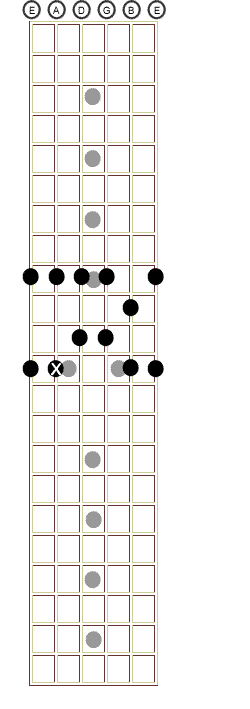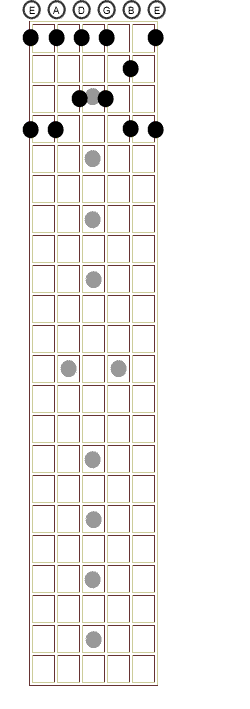Moving Chords
You cannot play every chord in the guitar’s open position.
What if you wanted to play an F or B chord? How about an F# or Gb chord for that matter? You can’t do it without using a barred chord. There are 12 possible major chords and without barre chords you can only play 5 of them. It’s the same thing with minor chords. A barre chord is where we take a basic chord pattern and “move” it up the neck of the guitar to create different chords.
For example, let’s take the E chord pattern:
To move the chord pattern up the neck, we create a barre with our 1st finger. This barre, in a way, replaces the nut of your guitar. The notes that were played open to produce the E chord will now be fingered with the barre that you create with your 1st finger.
If we were to move the entire pattern up one fret it would look like this:
 | It’s the same pattern, but now that we have moved the pattern up one fret, it’s no longer an E chord. Now it’s an F chord. The reason we know that it’s an F chord is because of the root note. The root note of the chord will be the lowest note. In the E chord, the root note was the low E string played open. Now that we have moved the chord shape up one fret the note on the first fret of the low E string is now the root note. That note is an F. Therefore we know we’re dealing with an F chord. |
This is one of the reasons why it is helpful to actually know the names of the notes on the fretboard. We can play all 12 possible major chords with this one chord pattern by moving it up the neck.
Below on the right is an A chord, because the root falls on the A note:
 |  |
Moving Scales
There is a big difference between a scale pattern and the actual scale. The actual scale is only 5 notes. When we are learning scale patterns we are learning the location of the notes from the scale as they appear on the fretboard. The same 5 notes repeat themselves over and over on the guitar’s fretboard. What we need to be able to do in order to play from the scale is memorize these fretboard patterns.
They Move!
Remember that these are patterns. To play in different key signatures we move the patterns around.
C Scale Pattern
1. In the 1st diagram we see the C scale pattern in the key of C#/Db.
2. In the 2nd diagram we see the C scale pattern in the key of D#/Eb.

3. In the 3rd diagram we see the C scale pattern in the key of A.




